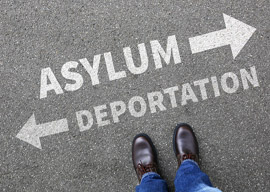
June 15, 2016

Source: Bigstock
Even Marxists despised anarchists as childish show-offs who only provoked bourgeois reaction with their vicious antics. When communists and anarchists nominally teamed up during the Spanish Civil War of the late 1930s, Joseph Stalin devoted far more energy to murdering his anarchist allies than to fighting the right.
Anarchist terrorists in the U.S. tended to be leftist atheists from either Catholic or Orthodox countries in Southern or Eastern Europe. Shooting heads of state or blowing up banks was known as “propaganda of the deed.”
For example, in 1901 President William McKinley was assassinated by Leon Czolgosz, a second-generation Pole. The last hurrah for anarchist terrorists may have been Giuseppe Zangara’s attack at an appearance by president-elect Franklin Roosevelt in 1933, which wound up killing Chicago mayor Anton Cermak.
The peak of anarchist terrorism in America came soon after WWI in an era of broad nervous breakdown across this country.
In 1919, followers of the Italian immigrant anarchist Luigi Galleani mailed three dozen letter bombs to prominent citizens. When the housekeeper of a U.S. senator had her hands blown off, an alert postal worker recognized that the bomb was the same as sixteen packages that had been set aside in his office due to insufficient postage.
The thwarted cheapskates then set off bigger bombs outside the homes of eight political figures, including Woodrow Wilson’s Attorney General, A. Mitchell Palmer, where an Italian terrorist managed to blow himself up. (One of his body parts landed on the doorstep of Palmer’s neighbors Franklin and Eleanor Roosevelt.) Palmer eventually responded by deporting 556 leftists, such as Emma Goldman and her former boyfriend Alexander Berkman, who had tried to assassinate industrialist Henry Clay Frick.
Then, in 1920, a couple of Italian-immigrant followers of Galleani, Sacco and Vanzetti, were arrested for murdering two workers in an armed robbery in the Boston area. The innocence of Sacco and Vanzetti became an immense cause célèbre for progressive intellectuals in the 1920s, although, as in so many similar recent fiascos, Sacco was likely the killer and Vanzetti his accomplice.
In September 1920, a huge bomb went off outside J.P. Morgan’s bank on Wall Street, probably as vengeance for the arrest of Sacco and Vanzetti. It killed three dozen civilians, mostly messenger boys and the like.
The Republicans, hugely victorious in the 1920 election, responded to these outrages with immigration restriction laws in 1921 and 1924.
The relevant question is: Did this democratic response drive Italian-Americans and Polish-Americans to new levels of violence, as so many now assume that any attempt to trim the levels of Muslim immigration would lead to even more Muslim domestic terrorism?
No, not really.
In fact, following this assertion of citizen authority over immigration policy, America calmed down rather quickly. The “20s were less agitated than the teens, and Depression America was remarkably stable. The thirty years from the apparent assassination attempt by an anarchist on FDR in 1933 to JFK’s murder by a communist in 1963 were among the most cohesive in American history.
A country that had appeared to be coming apart at the seams in 1919″20 went on to enjoy world-historical triumphs, with rapid assimilation to American norms by immigrants who were no longer reinforced by newcomers. Rather than answering with rage, Italians and Poles largely seemed to respond to this assertion of leadership by founding stock Americans as right and fitting.
Perhaps this historical analogy is an overly optimistic guide for a contemporary America dealing with a different set of immigrant groups.
But if we don”t try, how will we ever know?